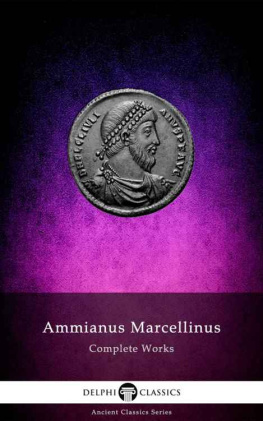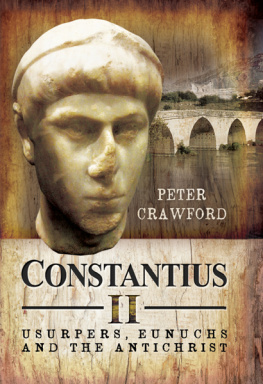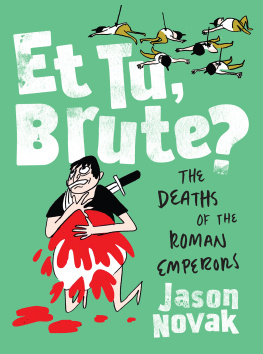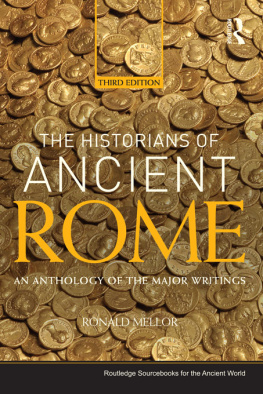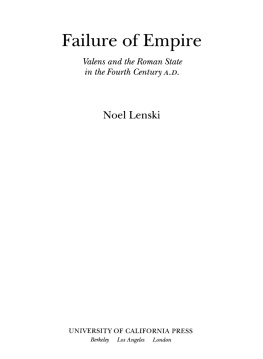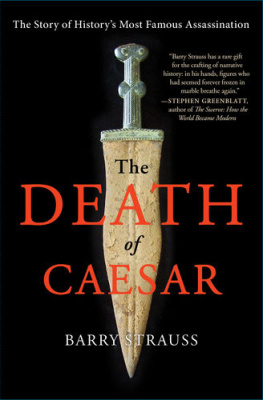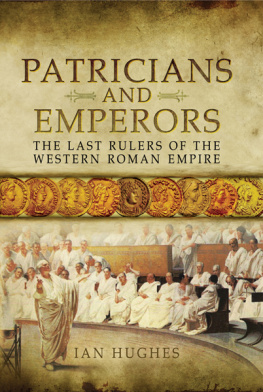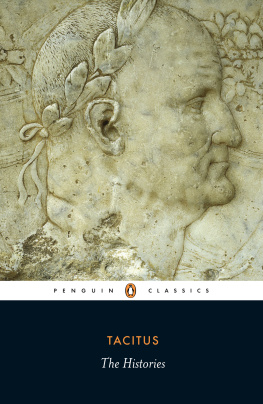Ammianus Marcellinus - The Later Roman Empire (A.D. 354-378)
Here you can read online Ammianus Marcellinus - The Later Roman Empire (A.D. 354-378) full text of the book (entire story) in english for free. Download pdf and epub, get meaning, cover and reviews about this ebook. City: Harmondsworth, year: 1986, publisher: Penguin Books, genre: Art. Description of the work, (preface) as well as reviews are available. Best literature library LitArk.com created for fans of good reading and offers a wide selection of genres:
Romance novel
Science fiction
Adventure
Detective
Science
History
Home and family
Prose
Art
Politics
Computer
Non-fiction
Religion
Business
Children
Humor
Choose a favorite category and find really read worthwhile books. Enjoy immersion in the world of imagination, feel the emotions of the characters or learn something new for yourself, make an fascinating discovery.
- Book:The Later Roman Empire (A.D. 354-378)
- Author:
- Publisher:Penguin Books
- Genre:
- Year:1986
- City:Harmondsworth
- Rating:5 / 5
- Favourites:Add to favourites
- Your mark:
- 100
- 1
- 2
- 3
- 4
- 5
The Later Roman Empire (A.D. 354-378): summary, description and annotation
We offer to read an annotation, description, summary or preface (depends on what the author of the book "The Later Roman Empire (A.D. 354-378)" wrote himself). If you haven't found the necessary information about the book — write in the comments, we will try to find it.
Considered to be the last great Roman historian, Ammianus Marcellinus continues the histories of Tacitus, describing the reigns of the emperors Constantius, Julian, Jovian, Valentinian, and Valens.
The Later Roman Empire (A.D. 354-378) — read online for free the complete book (whole text) full work
Below is the text of the book, divided by pages. System saving the place of the last page read, allows you to conveniently read the book "The Later Roman Empire (A.D. 354-378)" online for free, without having to search again every time where you left off. Put a bookmark, and you can go to the page where you finished reading at any time.
Font size:
Interval:
Bookmark:

THE LATER ROMAN EMPIRE
ADVISORY EDITOR: BETTY RADICE
AMMIANUS MARCELLINUS was the last great Roman historian. He was not a professional man of letters but an army officer of Greek origin born at Antioch and contemporary with the events described in what remains of his work. He set himself the task of continuing the histories of Tacitus from AD 96 down to his own day. The first thirteen of his thirty-one books are lost: the remainder describe a period of only twenty-five years (AD 354378) and the reigns of the emperors Constantius, Julian, Jovian, Valentinian and Valens, for which he is a prime authority. He was a pagan and an admirer of the apostate Julian, to whose career about half the surviving books are devoted. But his treatment of Christianity is free from prejudice and his impartiality and good judgement have been generally recognized. His style is sometimes bizarre, but in all the essential qualities of an historian he deserves the praise accorded to him by Gibbon and is well able to stand comparison with Livy and Tacitus.
WALTER HAMILTON was an Honorary Fellow of Magdalene College, Cambridge, where he was also Master from 1967 until 1978. He was born in 1908 and was a Scholar of Trinity College, Cambridge, where he gained first class honours in both parts of the classical Tripos. He was a fellow of Trinity College and a University Lecturer at Cambridge, and taught at Eton before becoming Headmaster of Westminster School (195057) and of Rugby School (195766). He has also translated Platos Symposium, the Gorgias, Phaedrus and Letters VII and VIII for Penguin Classics. Walter Hamilton died in 1988.
ANDREW WALLACE-HADRILL was born in 1951. He was Fellow and Lecturer in Classics at Magdalene College, Cambridge (197683), Lecturer in Ancient History at Leicester University (19837), and has been Professor of Classics at Reading University since 1987. His publications include Suetonius: the Scholar and his Caesars, Augustan Rome and Houses and Society in Pompeii and Herculaneum, as well as numerous studies of aspects of Roman social and cultural history.
AMMIANUS MARCELLINUS
(A.D. 354378)
Selected and translated by WALTER HAMILTON
With an Introduction and Notes by ANDREW WALLACE-HADRILL
PENGUIN BOOKS
PENGUIN BOOKS
Published by the Penguin Group
Penguin Books Ltd, 80 Strand, London WC2R 0RL, England
Penguin Putnam Inc., 375 Hudson Street, New York, New York 10014, USA
Penguin Books Australia Ltd, 250 Camberwell Road, Camberwell, Victoria 3124, Australia
Penguin Books Canada Ltd, 10 Alcorn Avenue, Toronto, Ontario, Canada M4V 3B2
Penguin Books India (P) Ltd, 11 Community Centre, Panchsheel Park, New Delhi 110 017, India
Penguin Books (NZ) Ltd, Cnr Rosedale and Airborne Roads, Albany, Auckland, New Zealand
Penguin Books (South Africa) (Pty) Ltd, 24 Sturdee Avenue, Rosebank 2196, South Africa
Penguin Books Ltd, Registered Offices: 80 Strand, London WC2R 0RL, England
www.penguin.com
This translation first published 1986
Reprinted 2004
25
Translation copyright Walter Hamilton, 1986
Introduction and Notes copyright Andrew Wallace-Hadrill, 1986
All rights reserved
Except in the United States of America, this book is sold subject to the condition that it shall not, by way of trade or otherwise, be lent, re-sold, hired out, or otherwise circulated without the publishers prior consent in any form of binding or cover other than that in which it is published and without a similar condition including this condition being imposed on the subsequent purchaser
ISBN: 9781101489604
In affectionate memory of Betty Radice,
who commissioned and approved this translation.
This volume contains in translation the major part of the extant books (1431) of the histories of Ammianus Marcellinus, which cover the years A.D. 354378. To keep within the bounds of a single Penguin volume some selection has been necessary, and the reader should be aware that this leaves a slightly unbalanced impression of Ammianus writing. Cuts have fallen most heavily on passages which do not affect the coherence of the narrative. One result is that the reign of Julian is more fully represented than those of Valentinian and Valens, which fall into a number of self-contained episodes. But the chief sacrifice has been a number of Ammianus celebrated digressions, mostly those on geography and natural phenomena. Some of these would be frankly tedious to a modern reader, but the digression was an integral feature of Ammianus approach to historical writing (cf. Introduction, 23), and we have tried to retain enough material of this type to give some idea of his method and the remarkable range of his interests. The omitted passages constitute about one fifth of the whole, and every omission is indicated in the text.
The text of Ammianus, for which we have to rely almost entirely upon a single ninth-century manuscript, is disfigured by many corruptions and lacunae, though fortunately the passages in which the meaning is seriously in doubt are comparatively few. The translator has not found it possible to follow any single modern editor implicitly. He has used his own judgement in the choice of readings, but has consulted throughout the new Teubner edition of W. Seyfarth, the volumes of the Bud series as far as they at present extend, and the Loeb edition of J. C. Rolfe. Passages where the corruption is hopeless and it is necessary to resort to conjecture are printed in italics, as are also the chapter headings, abbreviated in most cases from those in the manuscripts, which are themselves the work of an early editor. In effect, all words in italics are editorial.
Ammianus style is characterized briefly in the Introduction ( 24). Here the translator need only add that it is such that any attempt at a close rendering in modern English would be unreadable. But he has tried to preserve what he can of the flavour of Ammianus style, both in his occasional sublimities and in his not infrequent lapses into pomposity and even absurdity.
The subject-matter of Ammianus is diverse and wide-ranging, and the reader may often feel in need of explanation. Unfortunately, there is still no good historical commentary in English to which he can be referred. We have tried to provide what help is possible in the limited space available. It was not possible, nor in our view desirable, to provide comment in the Notes on all points of detail: for instance, Ammianus frequent mythological and historical allusions can be readily identified by consulting any standard work of reference (the Oxford Classical Dictionary, or the Penguin Whos Who in the Ancient World). Instead the Notes concentrate on more general features of the authors approach to his material in the form of a running commentary by chapters or groups of chapters. The identification of the surprisingly large number of individuals who recur at scattered points in the histories will be made easier by the Notes on Persons.
Geographical names present a special problem. Consistency would dictate the use of ancient forms throughout, but to retain Londinium or Mediolanum or Argentorate for London or Milan or Strasbourg would be merely irritating to the reader. In general, therefore, modern names are used in the text where they are well known and their identity certain, but ancient forms are added in brackets at least on first appearance. Ancient names are used in the maps, but cross-references in the Geographical Key will eliminate any difficulty.
This volume is the fruit of cooperation over a number of years. Though each of us has separate responsibility for the translation and the explanatory material, we read and discussed each others work at every stage; and we were rewarded to discover that our respect for and enjoyment of Ammianus grew progressively in the course of our work. We are also indebted in various ways to several friends, none of whom, of course, can be held responsible for our errors. The Introduction was greatly improved by the comments of Peter Garnsey and Michael Wallace-Hadrill, and both Introduction and Notes by those of John Matthews (we regret that we did not have the further benefit of John Matthewss major forthcoming book on Ammianus). Jamie Masters took on the donkey-work of map-making, and Michael Whitby helped to locate a number of place-names. Typing was cheerfully undertaken by Janet Bradford, Alwynne Gardner, and especially Jo Wallace-Hadrill (who suffered Ammianus in more ways than this).
Next pageFont size:
Interval:
Bookmark:
Similar books «The Later Roman Empire (A.D. 354-378)»
Look at similar books to The Later Roman Empire (A.D. 354-378). We have selected literature similar in name and meaning in the hope of providing readers with more options to find new, interesting, not yet read works.
Discussion, reviews of the book The Later Roman Empire (A.D. 354-378) and just readers' own opinions. Leave your comments, write what you think about the work, its meaning or the main characters. Specify what exactly you liked and what you didn't like, and why you think so.


